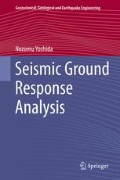Abstract
The equation of motion is introduced in Chap. 9 as
or
The damping term is recognized as the velocity proportional term in general. There is, however, more damping in the practice, which are listed in the following and will be explained in this chapter:
Access this chapter
Tax calculation will be finalised at checkout
Purchases are for personal use only
References
Central Disaster Prevention Council, Cabinet Office of Japan (2005) Report of expert committee on Tonankai and Tokai earthquakes (in Japanese)
Finn WDL, Martin GR, Lee MKW (1978) Comparison of dynamic analyses for saturated sands, earthquake engineering and soil dynamics, ASCE, GT special conference, vol 1, pp 472–491
Fukushima Y, Midorikawa S (1994) Evaluation of site amplification factors base on average characteristics of frequency dependent Q-1 of sedimentary strata. J Struct Constr Eng AIJ 460:37–46 (in Japanese)
Hara A, Kiyota Y (1977) Study on dynamic property of soil for the earthquake response analysis of ground -elastic shear modulus. In: Proceedings of the 14th Japan national conference of soil mechanics and foundation engineering, JSSMFE, Okinawa, pp 533–536 (in Japanese)
Ishida K et al (1984) On damping of ground -estimation of Q value by optimization-, programme and abstracts, the seismological society of Japan, p 149 (in Japanese)
Kiyota Y, Hagiwara T (1993) Earthquake response analysis based on equivalent linearization of soil constants in modal region part III estimation of damping property during very small ground motion, summaries of the technical papers of annual meeting of AIJ (Kanto), Tokyo, pp 217–218 (in Japanese)
Kokusho T (1986) Damping characteristics of soil, dynamic characteristics of soil for seismic response analysis. JSSMFE, pp 45–51 (in Japanese)
Kokusho T (1992) Dynamic characteristics of ground, lecture: analytical method of the interaction between ground and structure. Tsuchi-to-Kiso 40(4):76–84 (in Japanese)
Kurita T, Tsuzuki T, Annaka T, Shimada M, Fujitani M (1966) Scattering attenuation of seismic waves in inhomogeneous media. In: Proceedings of the 11th WCEE, Mexico
Muto K, Kobayashi T (1977) Comparative study of various damping theory frequently used in aseismic design of nuclear power plant. J Struct Constr Eng AIJ 255:35–45 (in Japanese)
Nakamura S, Sawada S, Yoshida N (2005) Modeling of surface ground for nonlinear analysis, Part 2. In: Proceedings of the 3rd symposium on strong motion prediction master plan for earthquake disaster reduction, pp 101–104 (in Japanese)
Ohsaki Y (1980) Vibration theory. Shokoku-sha, 302 pp (in Japanese)
Suetomi I (2000) A study on real time estimation of earthquake motion distribution during strong earthquake, theses submitted to Kyoto University for partial fulfillment of doctor’s degree (in Japanese)
Suetomi I, Yoshida N (1998) Damping characteristics of soil deposits during strong ground motions. In: Proceedings of the 2nd international symposium on the effect of surface geology on seismic motion, Yokosuka, Japan, vol 2, pp 765–772
Togawa H (1975) Vibration analysis by finite element method. Science-sha (in Japanese)
Yoshida N (1994) Applicability of conventional computer code SHAKE to nonlinear problem. In: Proceedings of symposium on amplification of ground shaking in soft ground, JSSMFE, pp 14–31 (in Japanese)
Yoshida N, Suetomi I, Kato N, Miura K (1997) Parametric study on effectiveness of dynamic response analysis by equivalent linear method. In: Proceedings of the 32nd Japan national conference of geotechnical engineering, pp 877–878 (in Japanese)
Yoshida N, Sawada S, Nakamura S (2006) Effect of damping on earthquake response of ground and its accuracy. J JAEE 4(4):55–73 (in Japanese)
Author information
Authors and Affiliations
Rights and permissions
Copyright information
© 2015 Springer Science+Business Media Dordrecht
About this chapter
Cite this chapter
Yoshida, N. (2015). Evaluation of Damping. In: Seismic Ground Response Analysis. Geotechnical, Geological and Earthquake Engineering, vol 36. Springer, Dordrecht. https://doi.org/10.1007/978-94-017-9460-2_12
Download citation
DOI: https://doi.org/10.1007/978-94-017-9460-2_12
Published:
Publisher Name: Springer, Dordrecht
Print ISBN: 978-94-017-9459-6
Online ISBN: 978-94-017-9460-2
eBook Packages: Earth and Environmental ScienceEarth and Environmental Science (R0)

